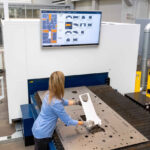ASIA ELECTRONICS INDUSTRYYOUR WINDOW TO SMART MANUFACTURING
Panasonic Automotive Advances Mobility in Neuron HPC
Panasonic Automotive Systems Company of America has announced its High-Performance Compute (HPC) system named Neuron. Particularly, this innovation addresses the rapidly evolving mobility needs anticipated for software-defined vehicle advancements.
As vehicles become more software reliant, vehicle systems must support the extended software lifecycle. Specifically, enabling software upgrades and prolonging the supporting hardware capability. Cars rely on hardware and software compute platforms to process, share, sense, and derive insights to handle functions for assisted driving.
Thus, Panasonic Automotive’s Neuron™ HPC allows for not only software updates and upgrades but also hardware upgrades across platform lifecycles.

The Neuron™ HPC can aggregate multiple computing zones to reduce the cost, weight and integration complexity of the vehicle by removing redundant components. In addition, Panasonic Automotive’s design supports effortless up-integration with high-performance and heavy data input processing capability. Most importantly, the design is upgradeable, scalable and future-proof across today’s evolving in-vehicle platforms.
Neuron HPC Architecture & Design
Panasonic Automotive’s High-Performance Compute architecture could reduce the number of distributed electronic control units (ECUs) by up to 80%. Hence, allowing for faster, lighter, cross-domain computing for real-time, cross-functional communications. The Neuron HPC design can suit any mobility platform including internal combustion engine, hybrid, fuel cell or electric vehicles.
“In collaboration with OEMs, Panasonic Automotive has designed and met some of the largest central compute platform challenges in the industry in order to make the driving experience evolve with technology,” said Andrew Poliak, CTO, Panasonic Automotive Systems Company of America. In addition, Poliak said, “Neuron™ maximizes performance, safety and innovation over the entire ownership of the consumer’s vehicle and enables OEMs with a future-proof SDV platform for ensuing generations of mobility needs.”
Key Systems, UX Features & Technical Benefits
With a streamlined design, the Neuron™ HPC incorporates up-integration capability by consolidating multiple ECUs into one centralized nucleus. Thus, enabling to handle all levels of ADAS, chassis, body, and in-cabin infotainment features.
Performance Features:
- Centralized Computing/Distributed Processing: Neuron™ can integrate various specialized computing processors like GPUs for brilliant visuals and neural processors/accelerators for A.I. into one centralized unit. Then, that centralized unit can distribute computing across these specialized processors for functional use cases spanning all levels of ADAS, predictive maintenance, safety and security.
- Scalable & Configurable: Neuron™ HPC is able to support performance scaled to nearly 10x the most advanced automotive compute core on the road today.
- Thermal Management: Integrates a liquid cooling design that can dissipate up to 1000W of heat
- Effortless Speed & Connectivity: The Neuron™ HPC architecture design also enables upgrading to newer technologies and standards when they are available for automotive use.
- SDV SW Framework: Neuron™ provides software framework to support standards based device virtualization, distributed computing and inter-domain communication. It also offers core microservices that can be used in multiple domains.
- Cyber Security: The Neuron™ utilizes VERZEUSETM, a suite of cyber security technologies and services offered by Panasonic Automotive. It provides security and robustness against cyber-attacks. VERZEUSETM enables monitoring of the network data and storage strengthening security-monitoring functions by implementing a multi-tiered verification process against a trusted source.
- Cloud-Native: The Neuron™ software platform development is truly “cloud-native.” In November 2023, Panasonic Automotive launched Virtual SkipGen™ (vSkipGen™) – a cloud-based development platform that virtualizes ECU and vehicle development. By activating vSkipGen™ plus Panasonic Automotive’s industry leading reference cockpit domain controller (CDC) components, this technology enables software updates to drop right onto the Neuron™ CDC card. This cloud-efficient approach reduces time to market and development spend to enhance the features, efficiencies and design of an HPC system.




